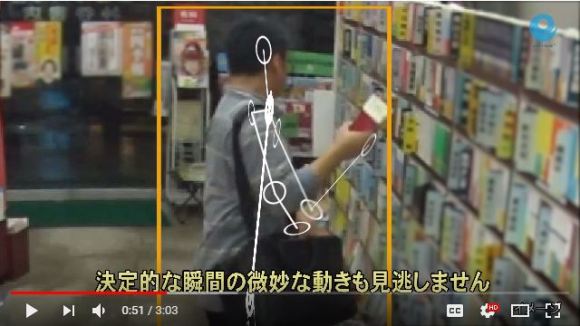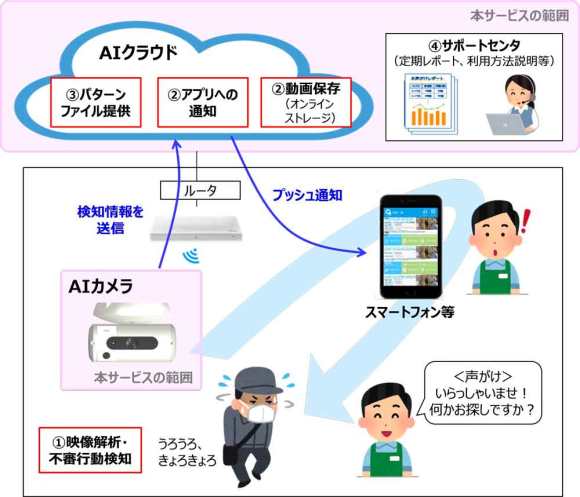
Now, if a clerk asks to help you, it probably means you’ve been acting shady.
Artificial intelligence continues to seep into our daily lives, touching up photos, developing snacks, and imitating school girls online. Now, AI has been tasked with tackling a crime as old as retail itself: shoplifting.
A recent study by telecom giant NTT found that Japanese businesses lose around 400 billion yen (US$3.7B) annually through five-fingered discounts. No store is immune to this larceny, except perhaps anvil shops, and technology has yet to come up with a strong enough solution to effectively combat it, until now.
https://www.youtube.com/watch?time_continue=51&v=amJfTgiy4KE
NTT and tech company Earth Eyes have joined up to create AI Guardman (“guardman” is the common Japanese-English word for “security guard”). This is a new type of security camera that is backed up with an AI system that can detect behaviors attributed to shoplifters.
The way it works is simple. The camera watches the store interior and identifies all the humans inside as they walk about. AI Guardman is aware of the different techniques commonly used by shoplifters in different types of stores, such as looking for blindspots in supermarkets or constantly checking one’s surroundings in bookstores.
If one shopper exhibits motions and postures typical of a shoplifter in that type of store, an alert will be sent to the clerk’s smartphone telling them the location and a photo of the suspect.
The clerk then goes over to the person and asks, “Good day! Can I help you find something today?” The friendly approach is effective enough at spooking potential sticky-fingers out of their thefts, but can also lead to genuine customer service in the event the AI screwed up.
Using their smartphone, the clerk logs whether or not they confronted the suspect, and the results are shared by both the store and AI Guardman system to improve their security. This way, even if shoplifters get wise to the system and begin to change their tactics, the AI can automatically keep up with them.
Preliminary tests appear to be effective as well. Trials have been conducted by major retailers such as electronics megastore Bic Camera, drug store Kirindo, and sporting goods store Xebio. One particular store reported a drop in shoplifting losses from 3.5 million yen ($32,000) per yer to 2 million ($18,000), and it is expected that the system will get stronger as it is used.
Before you consider buying one to protect your own personal valuables from pilfering siblings, the AI Guardman costs a fair amount. One camera, which has a range of 13 meters (43 feet) across 144 degree swath, costs 238,000 yen ($2,200) up front. Then, there’s the 4,500 yen ($41) per camera monthly fee for usage of the cloud data it produces.
Considering the potential savings in lost merchandise, it would be a small price to pay for businesses, however. It will also be interesting to see if humans can actually adapt to this AI and find more creative ways to steal, or if such technology will actually be the end of shoplifting as we know it.
On a personal level it will also be interesting. Sometimes, when I’m lingering extra long at the convenience store because I can’t decide if I want a curry donut or melon bread, I wonder if I’m looking particularly shopliftery. Now, when someone asks if they can help me, I’ll know for sure. Thanks AI!
Source: NTT, IT Media, Hachima Kiko
Top image: YouTube/Earth Eyes
Insert image: @Press (1, 2)



 This handsome anime-style security guard will be protecting actual homes and offices in Japan
This handsome anime-style security guard will be protecting actual homes and offices in Japan Every move you make, every step you take, this Japanese drug store will be watching you
Every move you make, every step you take, this Japanese drug store will be watching you Kura Sushi using AI camera network to prevent gross pranks at its revolving sushi restaurants
Kura Sushi using AI camera network to prevent gross pranks at its revolving sushi restaurants Robot security guards patrol Tokyo Metropolitan Government Building
Robot security guards patrol Tokyo Metropolitan Government Building One Piece’s Luffy is now working as an AI receptionist at manga publisher’s Tokyo office【Video】
One Piece’s Luffy is now working as an AI receptionist at manga publisher’s Tokyo office【Video】 Pizza Hut Japan’s hot lucky bags are perfect for a New Year’s pizza party
Pizza Hut Japan’s hot lucky bags are perfect for a New Year’s pizza party New Japanese menstrual product seeks to help women spot unidentified iron deficiencies
New Japanese menstrual product seeks to help women spot unidentified iron deficiencies Here are the top ten foodie factory tours for the fall throughout Japan
Here are the top ten foodie factory tours for the fall throughout Japan 7 hilarious/inexplicable Japan moments in South Park
7 hilarious/inexplicable Japan moments in South Park Kawaii Monster Land getting set to become Harajuku’s newest whimsical underground wonderland
Kawaii Monster Land getting set to become Harajuku’s newest whimsical underground wonderland We predict 7-Eleven’s new Zero Cider Triple drink is gonna be the hit drink of 2022【Taste Test】
We predict 7-Eleven’s new Zero Cider Triple drink is gonna be the hit drink of 2022【Taste Test】 Let’s go open a Lego Japan lucky bag…o
Let’s go open a Lego Japan lucky bag…o Tokyo’s new solo-customer-only cafe is an all-inclusive, view-filled paradise for party of one
Tokyo’s new solo-customer-only cafe is an all-inclusive, view-filled paradise for party of one Heading off the beaten path in Hokkaido for a beautiful view and local sweets
Heading off the beaten path in Hokkaido for a beautiful view and local sweets Japanese woman sues man for 1.5 million yen for violating her “right to chastity”
Japanese woman sues man for 1.5 million yen for violating her “right to chastity” Starbucks Japan ready to get Year of the Horse started with adorable drinkware and plushies【Pics】
Starbucks Japan ready to get Year of the Horse started with adorable drinkware and plushies【Pics】 7-Eleven Japan’s ramen-cooking robot whipped us up a bowl of noodles【Taste test】
7-Eleven Japan’s ramen-cooking robot whipped us up a bowl of noodles【Taste test】 Cyberpunk anime meets traditional culture in Ghost in the Shell gold leaf Japanese changing screens
Cyberpunk anime meets traditional culture in Ghost in the Shell gold leaf Japanese changing screens 7 great places to see Mt. Fuji from without having to climb it
7 great places to see Mt. Fuji from without having to climb it Hello Kitty Choco Egg figures are an adorable trip through three periods of Japanese pop culture【Pics】
Hello Kitty Choco Egg figures are an adorable trip through three periods of Japanese pop culture【Pics】 Japan’s otoshidama tradition of giving kids money at New Year’s gets a social welfare upgrade
Japan’s otoshidama tradition of giving kids money at New Year’s gets a social welfare upgrade We found possibly the quietest Japanese-style hotel in Tokyo’s bustling Shinjuku district
We found possibly the quietest Japanese-style hotel in Tokyo’s bustling Shinjuku district Lacquerware supplier to emperor of Japan and Pokémon team up for new tableware
Lacquerware supplier to emperor of Japan and Pokémon team up for new tableware Sumo Sanrio! Hello Kitty and pals team up with Japan Sumo Association for new merch【Pics】
Sumo Sanrio! Hello Kitty and pals team up with Japan Sumo Association for new merch【Pics】 Can a dirty butthole make you filthy rich in Japan? We’re starting a New Year’s lottery experiment
Can a dirty butthole make you filthy rich in Japan? We’re starting a New Year’s lottery experiment 7-Eleven Japan starts new temporary luggage storage service in over 300 branches
7-Eleven Japan starts new temporary luggage storage service in over 300 branches Disillusionment at Tsukiji’s tourist-target prices led us to a great ramen restaurant in Tokyo
Disillusionment at Tsukiji’s tourist-target prices led us to a great ramen restaurant in Tokyo Starbucks teams up with 166-year-old Kyoto doll maker for Year of the Horse decorations【Photos】
Starbucks teams up with 166-year-old Kyoto doll maker for Year of the Horse decorations【Photos】 Tokyo considering law requiring more trash cans following litter increase in heavily touristed area
Tokyo considering law requiring more trash cans following litter increase in heavily touristed area Tokyo’s Tsukiji sushi neighborhood asks tour groups to stay away for the rest of the month
Tokyo’s Tsukiji sushi neighborhood asks tour groups to stay away for the rest of the month Nintendo’s Kirby now delivering orders at Kura Sushi restaurants, but not in Japan
Nintendo’s Kirby now delivering orders at Kura Sushi restaurants, but not in Japan Tokyo event lets you travel back in time, for free, to celebrate 100 years since Showa era start
Tokyo event lets you travel back in time, for free, to celebrate 100 years since Showa era start Sanrio theme park in Japan announces plans to expand into a Sanrio resort
Sanrio theme park in Japan announces plans to expand into a Sanrio resort Japan may add Japanese language proficiency, lifestyle classes to permanent foreign resident requirements
Japan may add Japanese language proficiency, lifestyle classes to permanent foreign resident requirements Survey asks foreign tourists what bothered them in Japan, more than half gave same answer
Survey asks foreign tourists what bothered them in Japan, more than half gave same answer Japan’s human washing machines will go on sale to general public, demos to be held in Tokyo
Japan’s human washing machines will go on sale to general public, demos to be held in Tokyo Japan’s deadliest food claims more victims, but why do people keep eating it for New Year’s?
Japan’s deadliest food claims more victims, but why do people keep eating it for New Year’s? We deeply regret going into this tunnel on our walk in the mountains of Japan
We deeply regret going into this tunnel on our walk in the mountains of Japan Studio Ghibli releases Kodama forest spirits from Princess Mononoke to light up your home
Studio Ghibli releases Kodama forest spirits from Princess Mononoke to light up your home Major Japanese hotel chain says reservations via overseas booking sites may not be valid
Major Japanese hotel chain says reservations via overseas booking sites may not be valid Put sesame oil in your coffee? Japanese maker says it’s the best way to start your day【Taste test】
Put sesame oil in your coffee? Japanese maker says it’s the best way to start your day【Taste test】 No more using real katana for tourism activities, Japan’s National Police Agency says
No more using real katana for tourism activities, Japan’s National Police Agency says Starbucks Japan reveals new sakura drinkware collection, inspired by evening cherry blossoms
Starbucks Japan reveals new sakura drinkware collection, inspired by evening cherry blossoms Updated cherry blossom forecast shows extra-long sakura season for Japan this year
Updated cherry blossom forecast shows extra-long sakura season for Japan this year Artistic Japanese website AI has a long way to go before it can appropriately rate user’s Pikachu pics
Artistic Japanese website AI has a long way to go before it can appropriately rate user’s Pikachu pics Man who stole two packs of ground beef tracked by police for about 1,000 kilometers across Japan
Man who stole two packs of ground beef tracked by police for about 1,000 kilometers across Japan
Leave a Reply